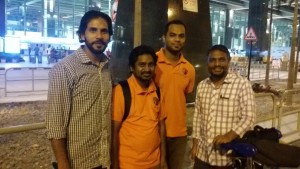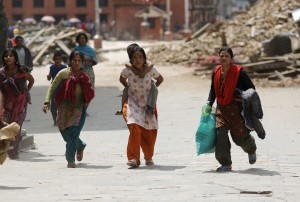In copertina:Vittime del terremoto a Kathmandu, in Nepal. Adnan Abidi, Reuters/Contrasto
You can never predict the kind of impact an earthquake of such magnitude will have on a densely populated urban area. Looking at the mass of people camping in the streets, it’s incredible that such a short event could wreak such havoc. Many of Kathmandu’s one million residents have slept in the open since Saturday, either because their homes were flattened or they were terrified that aftershocks would bring them crashing down. On Monday, thousands streamed out of the city. Roads leading from Kathmandu were jammed with people, some carrying babies, trying to climb onto buses or hitch rides aboard cars and trucks to the plains. Long queues had formed at the airport. High in the Himalayas, hundreds of climbers were staying put at Mount Everest base camp, where a huge avalanche after the earthquake killed 22 people in the single worst disaster to hit the world’s highest mountain. Despite the shock of the big quake, within minutes, the rescue teams set to work, and are now being joined by teams from Bangladesh, India and Pakistan. With unknown numbers still trapped beneath the rubble, the priority remains to get to them as soon as possible. The debris, landslides and aftershocks make it all the harder for the rescue teams. A series of aftershocks, severe damage from the quake, creaking infrastructure and a lack of funds have slowed the disbursement of aid to those most in need.
In Kathmandu, sick and wounded people were lying out in the open, unable to find beds in the devastated city’s hospitals. Surgeons set up an operating theatre inside a tent in the grounds of Kathmandu Medical College. Across the capital and beyond, exhausted families laid mattresses out on streets and erected tents to shelter from rain. People queued for water dispensed from trucks, while the few stores still open had next to nothing on their shelves. For the survivors, the most immediate needs are medical assistance, food, shelter and water. It has been raining since last night and is expected to continue for the coming days. For the thousands living out in the open, afraid to go home– or having lost their homes outright – shelter is a priority.
Rescue teams, helped by clear weather, used helicopters to airlift scores of people stranded at higher altitudes, two at a time. Some relief supplies also began to trickle into the capital. Some portable toilets had been set up and food was being provided by local aid agencies Foreign countries escalated efforts to get medical equipment, medicine, food, water, blankets, tents and search-and-rescue teams into Nepal, but chaotic scenes at the main international airport slowed the flow of aid. While aid has begun arriving in the capital, including food, medical supplies, tents and dogs trained for rescue efforts, the authorities are struggling to deliver relief further afield. Time is running out to find survivors among the rubble of collapsed buildings. In the north of Kathmandu, survivors suspended their search overnight, with plans to resume early on Tuesday. It is going to be devastating to see what has become of their homes, and their livelihoods. You can prepare, but nothing could have stopped this from happening. It was a massive quake, very strong but also very shallow and the impact has been enormous. Many had to buy food and water at exorbitant prices and spend the night in open spaces and vacant areas in and around Nepal’s only international airport.
 Nearly one million children in Nepal were severely affected by the quake, and warned of waterborne and infectious diseases. Families and friends of the victims lit hundreds of funeral pyres in towns and the countryside. Many people across Nepal slept in the open for a third night, their homes either flattened or threatened by tremors that spread more fear among a traumatised population. In Kathmandu, as elsewhere, thousands are sleeping on pavements, roads and in parks, many under makeshift tents. Hospitals are full to overflowing, while water, food and power are scarce, raising fears of waterborne diseases.
Nearly one million children in Nepal were severely affected by the quake, and warned of waterborne and infectious diseases. Families and friends of the victims lit hundreds of funeral pyres in towns and the countryside. Many people across Nepal slept in the open for a third night, their homes either flattened or threatened by tremors that spread more fear among a traumatised population. In Kathmandu, as elsewhere, thousands are sleeping on pavements, roads and in parks, many under makeshift tents. Hospitals are full to overflowing, while water, food and power are scarce, raising fears of waterborne diseases.
The big challenge is relief. We urge foreign countries to give us special relief materials and medical teams. The situation is worse in remote rural areas. Highways have been blocked by landslides and many villages and communities are without water and electricity, surviving on salvaged food and with no outside help. Our team is travelling today morning along with Caritas India. Bro. Madhu and Mr. Royce are part of the team and they would be accommodated in the pastoral centre of the Diocese. As regards the mode of operation and the kind of relief program, would be scoped out only after their arrival there in Nepal. We are for the moment focus on medical relief camps and the distribution of tents, medical care and medicines. Kindly continue to pray for the victims. Support and encourage our healthcare volunteers.
Contribution may be made to “Sneha Charitable trust for CTF Relief Fund”. Bank Details: The South Indian Bank, Sarjapur Road Branch. A/C Name: Camillian Task Force, A/C No: 0518053000007532 and IFSC Code SIBL 0000518 (Exempt u/s. 80g (5). Thanking you in anticipation.
or
A/C Name: Casa Generalizia Ord. dei Chierici Reg. Ministri degli Infermi, Bank: Banca Prossima SpA, Sportello di Roma IBAN IT62 G033 5901 6001 0000 0070 486 Swift: BCITITMX Cause: Emergency Nepal.
With a deep sense of solidarity
Fr. Baby Ellickal MI
Director of CTF















Camillians on Facebook
Camillians on Twitter
Camillians on Instagram